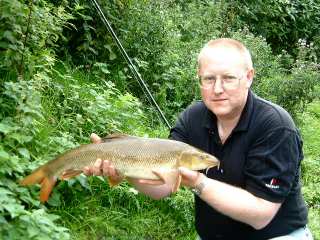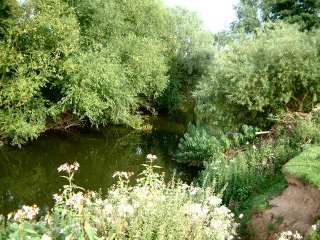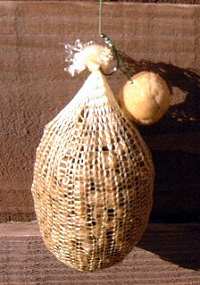|
|
| |
Dave will use heavy gear to fish for big barbel one day and a pole on ultra-light tackle the next to bag up on roach.
The emphasis on this series is how to enjoy your fishing no matter where you’re fishing or what you’re fishing for.
New Age Barbel
Specialist barbel anglers are beginning to reap the benefits ofthe lessons learned over many years of bait development by carpanglers. Specialist barbel boilies and paste mixes are becomingcommonplace on tackle shop shelves, and they are here to stay.
|
|
| |
Traditionalist anglers, who have for years fished the rivers forbarbel using little else other than meat, corn or casters fished overa bed of hemp, will probably be turning green. But to me, this newapproach is another string to my bow and I intend to make hay whilethe sun shines and enjoy every minute of it.
With a bit of experimentation and by adapting successful carpmethods and incorporating them with traditional barbel methods it ispossible to give a stretch of river that has become ‘difficult’ a newlease of life.
Team baiting campaign on the Teme
I am currently involved in a baiting campaign on a stretch of theriver Teme with a couple of mates, Paul Williams and Stewart Johnson. We agreed a few weeks ago on a particular bait mix and approach thatwe don’t believe the barbel have seen before and are now reaping therewards of weaning them on to the new food source. This is how wehave gone about it.
Firstly we agreed on the bait. A boilie approach would be the wayto go, accompanied by loose fed pellets. I have to say now that wehaven’t gone for a specialist ‘barbel’ flavour. It is a commerciallyavailable one, but from the carp world. I don’t think it isnecessary to home in straight away on a ‘barbel’ mix because,although I don’t doubt that they actually work, there are numerouscarp baits out there on the market that have equal appeal and withthe advantage that as they don’t have a ‘barbel’ label it’s highlyprobable that no-one else is using them. It’s a case ofexperimenting until you find a flavour that works and sticking withit until the barbel start to become wary of it.
|
|
| |
Once we had agreed the base mix and flavour we were going to useit was a question of getting the bait accepted on our chosen stretch. On each occasion that one or more of the three of us have visitedthe stretch we have baited up and fished with the agreed bait. Wealso introduce freebies into various swims along the stretch whetherwe intend to fish them that session or not. This has given the fishan opportunity to find and get used to eating a lot of the baitwithout being caught and hopefully overcoming any initial suspicionthat the new bait may cause.
A hybrid of barbel and carp techniques
The fishing itself is again a bit ‘hybrid’ in technique,incorporating traditional barbel methods with some carp type ones. The usual barbel rods and reels are required. Personally I now usethe new Fox barbel plus 1.75tc rod, which is in my opinion anexcellent one given the very reasonable price. It is capable ofstopping barbel in their tracks when hooked in snag infested swimsthat are all too common on the Teme. This is matched with my alltime favourite Shimano 5010 (I can’t see myself ever giving thesereels up!) which is loaded with either 12lb mono or 15lb braid. Ihave only just started using braid right through and the jury is out,but my initial finding is that I can stop barbel far more easilyusing it. I landed four out four first time out and if I continue tobe successful and don’t pull out of big fish I shall probably carryon using it.
The business end is set up in traditional barbel style as far asthe lead is concerned, incorporating a running leger. But thehooklength, as you would expect when using boilies, is a hairrig. Iam using Kryston braid hooklengths, either Silkworm or Super Nova in15lb bs with a size 6 Kamasan B988 power carp hook. The hair iscreated using the knotless knot.
The baiting approach
The initial baiting approach I use currently is as follows. Inlate summer, as it is now, I tend to arrive at the rivermid-afternoon, a good four hours before dark if possible. I thenselect my swim and bait up with a 50/50 hemp and partiblend mixintroduced through a baitdropper. I tend to use quite a lot of feed,usually around five or six pints, sometimes a bit more. I thenintroduce five or six droppers of pellets and around 20 of ourselected boilies and, when finished, I go for a walk for a couple ofhours.
The walk is for three reasons. Firstly, wandering along the banksof the Teme is far better than working any day. I would be quitehappy doing this even if I didn’t have my gear set up ready for thebarbel. Just wandering from swim to swim, peering into the water totry and spot some fish or to observe the bottom features is quitesatisfying in itself. Secondly, it gives me an opportunity tointroduce some of the bait, as described above, along the stretch.
At various swims along the river I throw in around 20 boilies,giving the barbel a free meal and getting them accustomed to findingthe bait all along the stretch, not just in one or two swims. Thirdly, it gives the barbel time to move onto my baited area andstart feeding with confidence as the light levels start to drop.
A quiet move into the swim
I only actually fish for around three hours. I quietly move backinto my swim at my chosen fishing time, usually around an hour and ahalf before dark. First cast is made with a boilie only which iswrapped in a paste of the boilie base mix. This gives the hook baitan added attraction as the paste breaks down around it. On mostsessions this year, a bite has not been long in coming – the usualbarbel tap that bends your rod in half.
|
|
| |
After taking a fish I recast immediately to the swim, but thistime I incorporate another carp trick by attaching a PVA bag ofpellet to the hook. This has proved crucial. The swim needs toppingup with bait but I don’t want to splash a bait dropper in thevicinity of any feeding fish. Introducing pellets by hand orcatapult in even moderately flowing water is a hit and miss affair asthe pellets I’m using sink very slowly and spread all over the place. If I can’t keep the feed tight I would rather not put it in. Thebarbel absolutely love the pellets and by using the PVA bag I know Ihave a good supply of them right by my hookbait. Usually, whenconditions are right, it’s not long before the rod is going roundagain.
A method that will endure into winter
In all honesty, I have not failed to hook-up at least twice on asession this year and four hook-ups is more often the norm especiallynow the barbel are accepting the bait. This method works and I’m surethat if I was using plain old meat I would not be hooking as manyfish.
I also believe that this method will endure into winter. I shallbe cutting back on the amount of hemp/partiblend mix, probably notfeeding any at all most times and fishing the PVA bag and boiliemethod exclusively. I shall also be adopting a more mobile approachand fishing much earlier in the day, dropping into a swim for perhapshalf an hour and then moving on.
This ‘new age’ barbel method is a winner and a very enjoyablemethod. It will work on all sorts of waters, from the biggest tosmallest of rivers. It’s a case of finding a bait that works andthen getting the barbel feeding on it. Give it a try and get somemore barbel on the bank, purely for pleasure of course.














